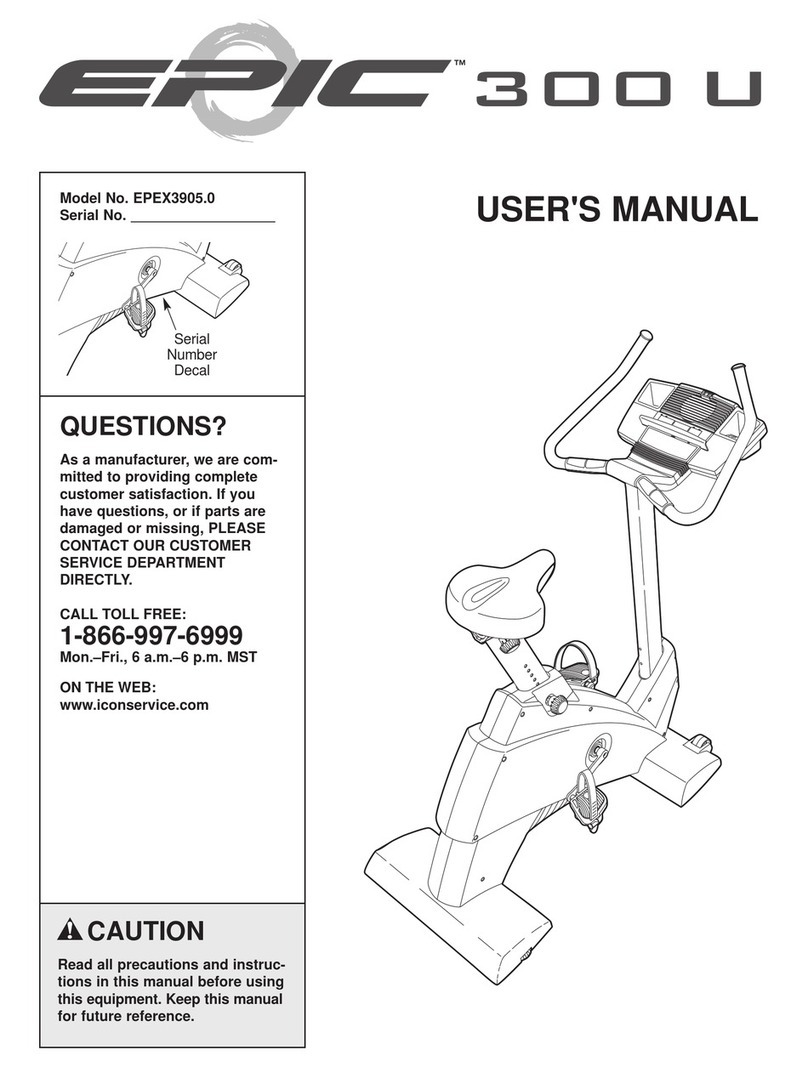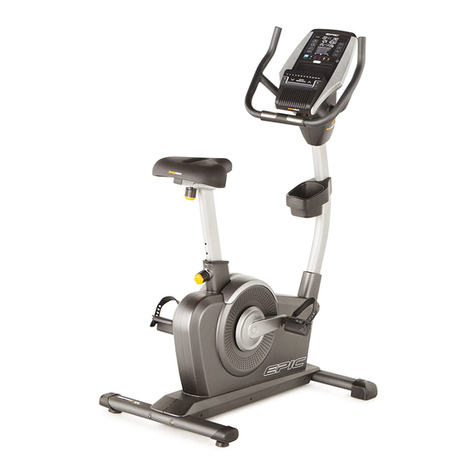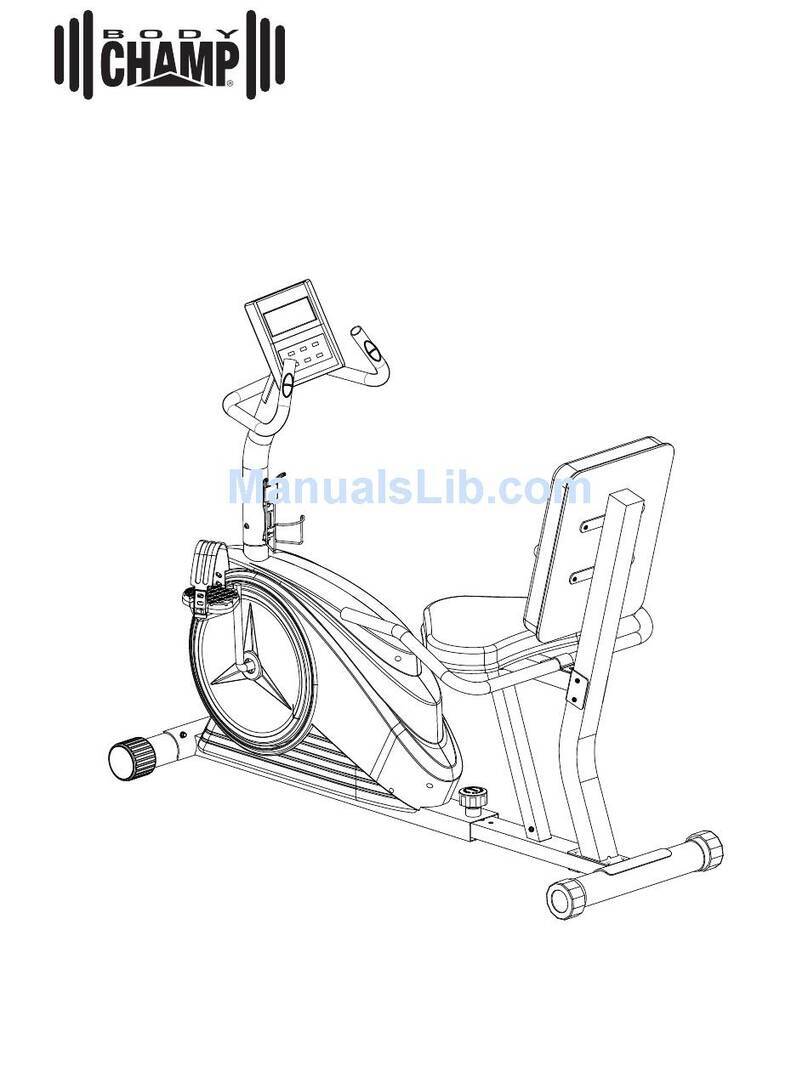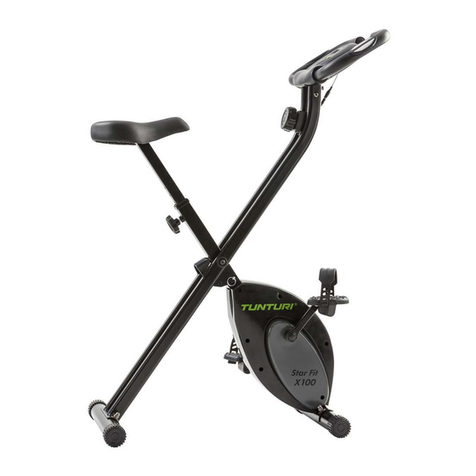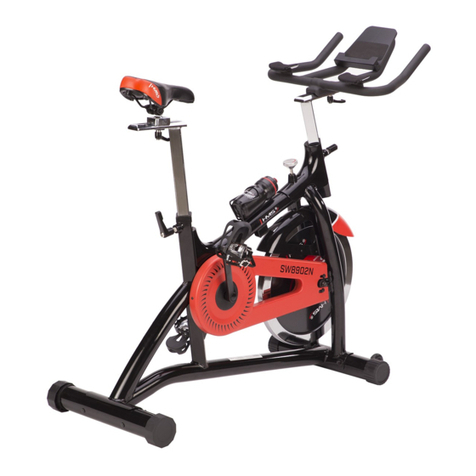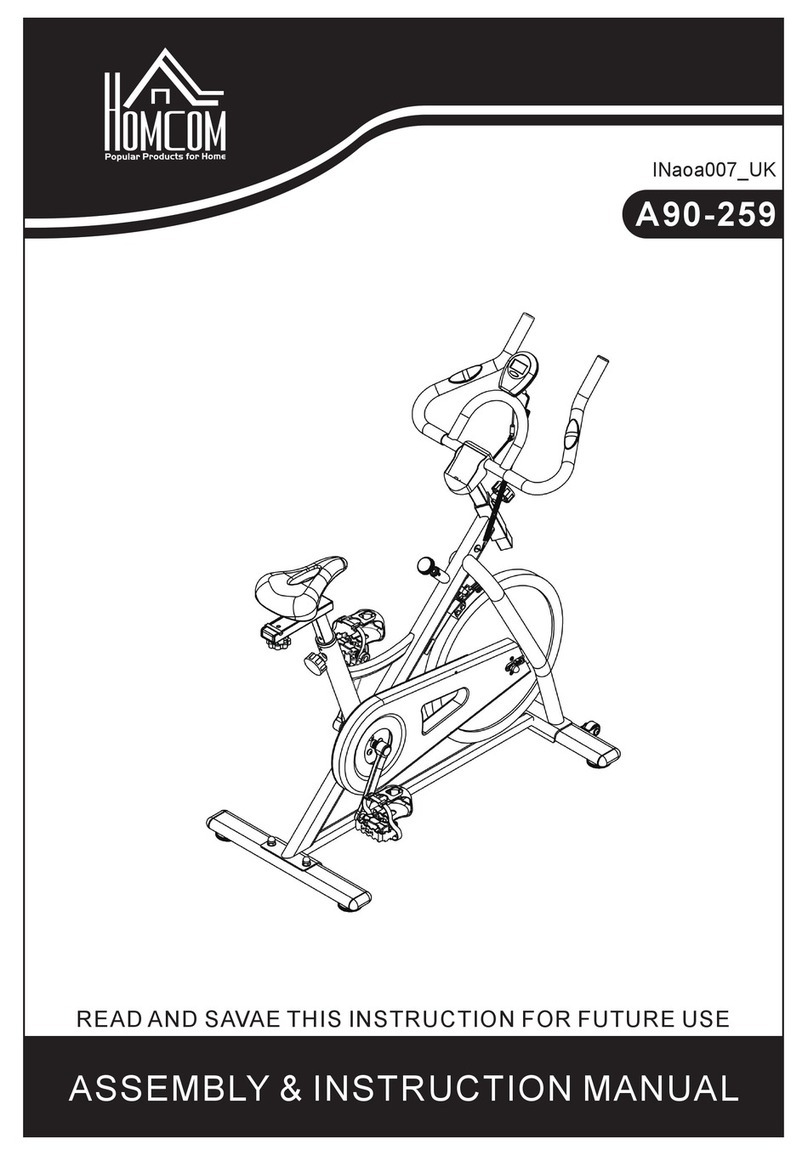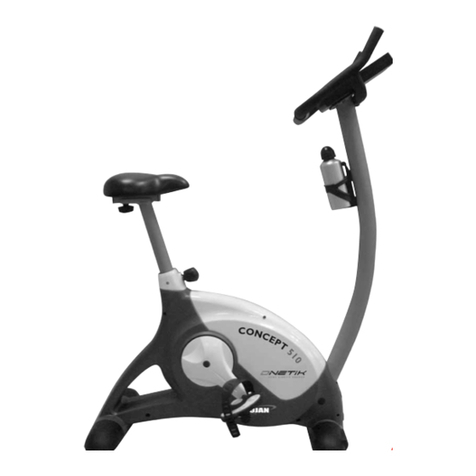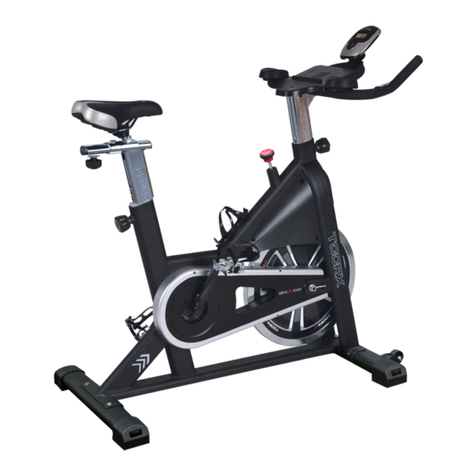Epic 420 R Bike User manual

USER'S MANUAL
CAUTION
Read all precautions and instruc-
tions in this manual before using
this equipment. Keep this manual
for future reference.
Serial Number
Decal
Model No. EPEX4905.0
Serial No.
QUESTIONS?
As a manufacturer, we are com-
mitted to providing complete
customer satisfaction. If you
have questions, or if parts are
damaged or missing, PLEASE
CONTACT OUR CUSTOMER
SERVICE DEPARTMENT
DIRECTLY.
CALL TOLL FREE:
1-866-997-6999
Mon.–Fri., 6 a.m.–6 p.m. MST
ON THE WEB:
www.iconservice.com

2
TABLE OF CONTENTS
IMPORTANT PRECAUTIONS . . . . . . . . . . . . . . . . . . . . . . . . . . . . . . . . . . . . . . . . . . . . . . . . . . . . . . . . . . . . . . . .3
BEFORE YOU BEGIN . . . . . . . . . . . . . . . . . . . . . . . . . . . . . . . . . . . . . . . . . . . . . . . . . . . . . . . . . . . . . . . . . . . . . .4
ASSEMBLY . . . . . . . . . . . . . . . . . . . . . . . . . . . . . . . . . . . . . . . . . . . . . . . . . . . . . . . . . . . . . . . . . . . . . . . . . . . . . . .5
HOW TO OPERATE THE EXERCISE CYCLE . . . . . . . . . . . . . . . . . . . . . . . . . . . . . . . . . . . . . . . . . . . . . . . . . . .10
MAINTENANCE AND TROUBLESHOOTING . . . . . . . . . . . . . . . . . . . . . . . . . . . . . . . . . . . . . . . . . . . . . . . . . . .17
EXERCISE GUIDELINES . . . . . . . . . . . . . . . . . . . . . . . . . . . . . . . . . . . . . . . . . . . . . . . . . . . . . . . . . . . . . . . . . . .18
PART LIST . . . . . . . . . . . . . . . . . . . . . . . . . . . . . . . . . . . . . . . . . . . . . . . . . . . . . . . . . . . . . . . . . . . . . . . . . . . . . .21
EXPLODED DRAWING . . . . . . . . . . . . . . . . . . . . . . . . . . . . . . . . . . . . . . . . . . . . . . . . . . . . . . . . . . . . . . . . . . . .22
HOW TO ORDER REPLACEMENT PARTS . . . . . . . . . . . . . . . . . . . . . . . . . . . . . . . . . . . . . . . . . . . . .Back Cover
LIMITED WARRANTY . . . . . . . . . . . . . . . . . . . . . . . . . . . . . . . . . . . . . . . . . . . . . . . . . . . . . . . . . . . . . .Back Cover

3
IMPORTANT PRECAUTIONS
WARNING:To reduce the risk of serious injury, read the following important precau-
tions before using the exercise cycle.
1. Read all instructions in this manual and all
warnings on the exercise cycle before
using the exercise cycle.
2. Use the exercise cycle only as described in
this manual.
3. It is the responsibility of the owner to
ensure that all users of the exercise cycle
are adequately informed of all precautions.
4. Use the exercise cycle indoors on a level
surface. Keep the exercise cycle away from
moisture and dust. Place a mat under the
exercise cycle to protect the floor or carpet.
Make sure that there is enough clearance
around the exercise cycle to mount, dis-
mount, and use it.
5. Inspect and properly tighten all parts regu-
larly.Replace any worn parts immediately.
6. Keep children under the age of 12 and pets
away from the exercise cycle at all times.
7. The exercise cycle should not be used by
persons weighing more than 250 pounds.
8. Wear suitable clothes when using the exer-
cise cycle; do not wear loose clothes that
could become caught on the exercise cycle.
Always wear athletic shoes.
9. Always keep your back straight when using
the exercise cycle. Do not arch your back.
10.If you feel pain or dizziness while exercis-
ing, stop immediately and cool down.
11. The pulse sensor is not a medical device.
Various factors, including the user's move-
ment, may affect the accuracy of heart rate
readings. The pulse sensor is intended only
as an exercise aid in determining heart rate
trends in general.
12.The exercise cycle is intended for in-home
use only. Do not use the exercise cycle in a
commercial, rental, or institutional setting.
WARNING:Before beginning this or any exercise program, consult your physician. This
is especially important for persons over the age of 35 or persons with pre-existing health problems.
Read all instructions before using. ICON assumes no responsibility for personal injury or property
damage sustained by or through the use of this product.

4
Congratulations for selecting the new EPIC 420 R
exercise cycle. Cycling is one of the most effective
exercises for increasing cardiovascular fitness, building
endurance, and toning the entire body. The EPIC 420
Rexercise cycle offers an impressive array of fea-
tures designed to let you enjoy this healthful exercise
in the comfort and privacy of your home.
For your benefit, read this manual carefully before
you use the exercise cycle. If you have questions
after reading this manual, see the front cover of this
manual. To help us assist you, mention the product
model number and serial number when calling. The
model number is EPEX4905.0. The serial number can
be found on a decal attached to the exercise cycle
(see the front cover of this manual for the location of
the decal).
To avoid a registration fee for any service needed
under warranty, you must register the exercise
cycle at www.iconservice.com/registration.
Before reading further, please familiarize yourself with
the parts that are labeled in the drawing below.
Seat Handle
Fan
Water Bottle Holder*
*No water bottle is included
FRONT
REAR
Backrest
Seat
Wheel
Pedal/Strap
Console
Bookrack
Handlebar/Pulse Sensor
Seat Knob
Leveling Foot
RIGHT SIDE
BEFORE YOU BEGIN

5
ASSEMBLY
To hire an authorized technician to assemble the exercise cycle, call toll-free 1-800-445-2480.
Assembly requires two persons. Place all parts of the exercise cycle in a cleared area and remove the packing
materials. Do not dispose of the packing materials until assembly is completed.
Assembly requires the included tools and your own adjustable wrench .
Use the drawings below to identify the small parts used in assembly. The number in parenthesis below each
drawing refers to the key number of the part, from the PART LIST on page 21. The second number refers to the
quantity needed for assembly. Note: Some small parts may have been pre-assembled for shipping. If a part
is not in the parts bag, check to see if it has been pre-assembled.
M10 Nylon
Locknut (63)–2
M8 Split
Washer (55)–12 M10 Split
Washer (88)–2
M8 Washer
(60)–4
M10 x 52mm Button Bolt (82)–2
M8 Nylon
Locknut (89)–4
M8 x 40mm Button
Bolt (81)–4
M10 x 118mm Button Screw (78)–2
M8 x 25mm Button
Screw (79)–4
M4 x 16mm
Screw (57)–5 1/4” x 16mm Button
Screw (80)–8 M8 x 40mm Button
Screw (54)–8
1. Identify the Front Stabilizer (15). While another person
lifts the front of the Frame (1), attach the Front
Stabilizer to the Frame with four M8 x 40mm Button
Screws (54) and four M8 Split Washers (55).
15
1
55
55 54
54
1

6
2. While another person lifts the rear of the Frame (1),
attach the Rear Stabilizer (16) to the Frame with four
M8 x 40mm Button Screws (54) and four M8 Split
Washers (55).
3
2
1
78
78
88
88
43
102
102
3. Have another person hold the Upright (2) in the posi-
tion shown. See the inset drawing. Locate the wire
extending from the bottom of the Upright. Tie the wire
around the end of the Wire Harness (43) as shown.
Carefully pull the wire up through the Upright until the
Wire Harness is extending from the top of the Upright.
Then, untie the wire and discard it.
Carefully pull the end of the Wire Harness (43) to
remove any slack. Insert the Upright (2) into the
Frame (1); be careful to avoid pinching the Wire
Harness. Attach the Upright with two M10 x 118mm
Button Screws (78), two M10 Split Washers (88), and
two Upright Spacers (102). Make sure the concave
end of each Upright Spacer is turned toward the
Upright.
Do not pinch
the Wire
Harness (43)
during this
step.
16
1
55
55 54
54
2
43
Wire
4. Identify the Left Handlebar (70), which is marked with a
sticker. While another person holds the Left Handlebar
near the Upright (2), connect the left Pulse Sensor Wire
(6) to the Pulse Wire (3). Next, slide the Left Handlebar
onto the left tube on the Upright; be careful to avoid
pinching the Wires. Insert two M8 x 40mm Button
Bolts (81) into the Left Handlebar and the tube on the
Upright; be careful not to damage the Wires with the
Button Bolts. Finger tighten two M8 Nylon Locknuts
(89) onto the Button Bolts. Next, slide the Handlebar
Collar (98) onto the upper end of the Left Handlebar.
Attach the Right Handlebar (72) as described above.
Note: As you slide the Right Handlebar onto the right
post on the Upright (2), insert the upper end of the
Right Handlebar into the Left Handlebar (70).
Connect the Handlebars (70, 72) with the Handlebar
Collar (98) and an M4 x 16mm Screw (57). Then, tight-
en the four M8 x 40mm Button Bolts (81); make sure
the M8 Nylon Locknuts (89) are seated in the
hexagonal holes in the Handlebars.
Tube
32
6
70
72
Make sure the wires
do not get damaged
during this step.
81
89
4
98
57

7
7. Attach the Seat Frame (7) to the Seat Carriage (11)
with two M10 x 52mm Button Bolts (82) and two M10
Nylon Locknuts (63). 63
7
11
6. Attach the Seat (9) to the Seat Frame (7) with four 1/4”
x16mm Button Screws (80) and four M8 Washers (60).
7
80
60
60
9
6
7
82
5. Have another person hold the Console (4) near the
Upright (2).
Connect the Wire Harness (43) to the wire harness on
the Console (4). Next, connect the Pulse Wire (3) to
the pulse wire on the Console. Then, connect the indi-
cated ground wire to the smallest wire on the Console.
Carefully insert all excess wiring down into the Upright
(2). Attach the Console (4) to the Upright with four M4
x16mm Screws (57). Be careful to avoid pinching
the wires. Next, press the bookrack onto the Console
in the indicated location.
4
Ground Wire
2
57
43
3
5
Do not pinch
the wires
during this step.
Bookrack

8
10. Make sure that all parts are properly tightened before you use the exercise cycle. Note: After assembly is
completed, some extra parts may be left over.Place a mat beneath the exercise cycle to protect the floor.
9. Identify the Left Pedal (22), which is marked with an
“L.” Using an adjustable wrench, firmly tighten the
Left Pedal
counterclockwise
into the Left Crank Arm
(24). Tighten the Right Pedal (not shown)
clockwise
into the Right Crank Arm. Important: Tighten both
Pedals as firmly as possible. After using the
exercise cycle for one week, retighten the
Pedals. For best performance, the Pedals must
be kept tightened.
Identify the Left Pedal Strap (25), which is marked
with an “L.” Attach the Left Pedal Strap to the Left
Pedal (22), and adjust it to the desired position.
Attach and adjust the Right Pedal Strap (not shown)
in the same way.
9
22 24
25
8. Attach the Backrest (62) to the Backrest Frame (42)
with four 1/4” x 16mm Button Screws (80).
Slide the Backrest Frame (42) onto the Seat Frame
(7). Attach the Backrest Frame with four M8 x 25mm
Button Screws (79) and four M8 Split Washers (55).
62
7
80
79
55
55 79
42
8

9
INSTALLING THE RECEIVER FOR THE OPTIONAL CHEST PULSE SENSOR
Ifyou purchase the optional chest pulse sensor (see page 11), follow the steps below to install the receiver
included with the chest pulse sensor.
Remove the access door from the underside of the
Console (4). Note: You may need to use a small standard
screwdriver to remove the access door.
Slide the receiver onto the indicated plastic pin on the
Console (4); make sure that the receiver is oriented
exactly as shown. Locate the two small screws included
with the chest pulse sensor. Attach the receiver to the
Console with the two screws as shown.
Connect the wire on the receiver to the indicated wire on
the Console (4).
Reattach the access door. Make sure that no wires are
pinched. Note: The other wires included with the chest
pulse sensor may be discarded.
Pin
Access
Door
Wire
Screws
4
Receiver

10
HOW TO OPERATE THE EXERCISE CYCLE
HOW TO MOVE AND LEVEL THE EXERCISE
CYCLE
Stand in back of the exercise cycle, and lift the exer-
cise cycle until it can be moved on the front wheels.
Move the exercise cycle to the desired location and
carefully lower it. Due to the weight of the exercise
cycle, use extreme caution while moving it.
If the exercise cycle
rocks slightly on
your floor during
use, turn the level-
ing feet under the
rear stabilizer until
the rocking motion
is eliminated.
HOW TO ADJUST THE SEAT
The seat can be
adjusted to the posi-
tion that is the most
comfortable for you.
To adjust the seat,
pull the seat knob,
slide the seat for-
ward or backward,
and then release
the seat knob. Move
the seat forward or
backward slightly
until the pin on the
seat knob snaps into one of the holes in the seat rail.
HOW TO ADJUST THE PEDAL STRAPS
The pedal straps
can be adjusted to
the position that is
the most comfort-
able for you. Press
the tabs on the ped-
als, adjust the
straps to the
desired position,
and then release
the tabs.
Leveling
Foot
Wheel
Seat Seat
Knob
Pedal
Strap
Tab

11
FEATURES OF THE CONSOLE
The advanced console offers a selection of features
designed to make your workouts more enjoyable and
effective. When the manual mode of the console is
selected, the resistance of the pedals can be changed
with the touch of a button. As you exercise, the con-
sole will provide continuous exercise feedback. You
can even measure your heart rate using the handgrip
pulse sensor or the optional chest pulse sensor.
The console also offers eight resistance and pace pro-
grams. Each program automatically changes the resis-
tance of the pedals and prompts you to increase or
decrease your pace as it guides you through an effec-
tive workout.
In addition, the console features two heart rate pro-
grams that automatically change the resistance of the
pedals and prompt you to vary your pace to keep your
heart rate near a target heart rate as you exercise.
THE OPTIONAL CHEST PULSE SENSOR
The optional chest
pulse sensor pro-
vides hands-free
operation and con-
tinuously monitors
your heart rate dur-
ing your workouts.
To purchase the
optional chest
pulse sensor,call
the toll-free tele-
phone number on the front cover of this manual.
CONSOLE DIAGRAM
Note: If there is a sheet of clear plastic on the face of the console, remove it before using the console.
Matrix Target RPM Bar
Left Display

12
HOW TO USE THE MANUAL MODE
Begin pedaling to activate the console.
The exercise cycle requires no batteries or
external power source. Power is supplied by a
generator as you pedal. To activate the console,
begin pedaling at a speed of about 3 miles per
hour or faster. After a few seconds, the console
displays will light. A tone will then sound and the
console will be ready for use.
Select the manual mode.
When the power is
turned on, the
manual mode will
be selected. If you
have selected a
program, select
the manual mode
by pressing the Heart Rate Programs button
repeatedly until a track appears in the matrix.
Begin pedaling and change the resistance of
the pedals as desired.
As you pedal,
change the resis-
tance of the ped-
als by pressing the
Resistance but-
tons. There are
ten resistance lev-
els. Note: After the Resistance buttons are
pressed, it will take a moment for the pedals to
reach the selected resistance level.
Monitor your progress with the matrix and the
displays.
The matrix—
When the manual
mode is selected,
the matrix will
show a track rep-
resenting 1/4 mile.
As you exercise,
the indicators around the track will light in succes-
sion until the entire track is lit. The track will then
darken and the indicators will again begin to light
in succession.
The left display—
The left display will
show the elapsed
time, the resistance
level, your pedaling
speed, and the dis-
tance you have
pedaled. The display will change from one num-
ber to the next every few seconds, as shown by
the indicators around the display. Note: When a
program is selected, the display will show the time
remaining in the program instead of the elapsed
time. Each time the resistance of the pedals
changes, the display will show the resistance
level.
The right
display—The right
display will show
your pedaling pace
(in revolutions per
minute [RPM]) and
the approximate
numbers of
fat calories
and
calories
you have
burned (see FAT BURNING on page 18). The dis-
play will change from one number to the next
every few seconds, as shown by the indicators.
The display will also show your heart rate when
you use the handgrip pulse sensor or the optional
chest pulse sensor. Note: When a heart rate pro-
gram is selected, the display will show only your
heart rate.
Note: The console
can display speed
and distance in
either miles or kilo-
meters. To find
which unit of mea-
surement is select-
ed, you must select the console’suser mode.
Hold down the Resistance Programs button for
about five seconds. The letter “E” for English
miles or the letter “M” for metric kilometers will
appear in the right display. To change the unit of
measurement, press the + button. The left display
will show the total distance pedaled. Toexit the
user mode, press the Resistance Programs button
again.
4
3
2
1

13
Measure your heart rate if desired.
Note: If you hold the handgrip pulse sensor
and wear the optional chest pulse sensor at
the same time, the console will not display
your heart rate accurately.
If there are
sheets of
clear plastic
on the metal
contacts on
the handgrip
pulse sensor,
peel off the
plastic. To
measure your
heart rate,
hold the handgrip pulse sensor with your palms
resting on the contacts. Avoid moving your
hands.
When your pulse
is detected, the
Heart Rate indica-
tor above the right
display will light,
one or two dashes
(– –) will appear in
the right display,and then your heart rate will be
shown. For the most accurate heart rate reading,
hold the contacts for at least 15 seconds.
Note: If you continue to hold the pulse sensor,the
right display will show your heart rate for up to 30
seconds. The display will then show your heart
rate along with the other modes.
If your heart rate is not shown, make sure that
your hands are positioned as described. Be care-
ful not to move your hands excessively or to
squeeze the metal contacts too tightly. For opti-
mal performance, clean the metal contacts using
asoft cloth; never use alcohol, abrasives, or
chemicals.
Turn on the fan if desired.
To turn on the fan at low speed, press the Fan
button. Pivot the fan to the desired angle. To turn
on the fan at high speed, press the Fan button a
second time. To turn off the fan, press the Fan
button a third time.
When you are finished exercising, the console
will automatically turn off.
If the pedals are not moved for several seconds, a
tone will sound, the console will pause, and the
left display will begin to flash.
If the pedals are not moved for about one minute,
the console will turn off, but the displays will not
be reset. If the pedals are not moved for about
five minutes, the console will turn offand the dis-
plays will be reset.
7
6
5
Contacts

14
HOW TO USE A RESISTANCE AND PACE
PROGRAM
Begin pedaling to activate the console.
See step 1 on page 12.
Select one of the resistance and pace
programs.
To select a resis-
tance and pace
program, press the
Resistance
Programs button
repeatedly until
“P 3,” “P 4,” “P 5,”
“P 6,” “P 7,” “P 8,” “P 9,” or “P10” appears in the
right display.
When a resistance and pace program is selected,
aprofile of the resistance settings of the program
will scroll across the matrix. The left display will
show the highest resistance level of the program
for a few seconds, and then it will show how long
the program will last.
Press the Program Start button or begin
pedaling to start the program.
Each program is divided into either 20 or 30 one-
minute segments. One resistance setting and one
pace setting are programmed for each segment.
Note: The same resistance setting and/or pace set-
ting may be programmed for two or more consecu-
tive segments.
The resistance
setting for the first
segment will be
shown in the flash-
ing Current
Segment column
of the matrix. (The
pace settings are
not shown in the matrix.) The resistance settings
for the next several segments will be shown in the
columns to the right.
As you exercise,
the Target RPM bar
will help you to
keep your pedaling
pace near the pace
setting for the cur-
rent segment.
When one of the “too slow” indicators lights,
increase your pace. When one of the “too fast”
indicators lights, decrease your pace. When one
of the center indicators lights, maintain your cur-
rent pace. Important: The pace settings are
intended only to provide motivation. Your
actual pace may be slower than the current
pace setting. Make sure to exercise at a pace
that is comfortable for you.
When only three seconds remain in the first seg-
ment of the program, both the Current Segment
column and the column to the right will flash, a
series of tones will sound, and
all resistance set-
tings will move one column to the left.
The resis-
tance setting for the second segment will then be
shown in the flashing Current Segment column
and the resistance of the pedals will automatically
change to the resistance setting for the second
segment.
Note: If all of the indicators in the Current Segment
column are lit after the resistance settings have
moved to the left,
the resistance settings will move
downward so only the highest indicators appear in
the matrix.
The program will continue until the resistance set-
ting for the last segment is shown in the Current
Segment column and no time remains in the pro-
gram.
Note: During the program, you can override the
resistance setting for the current segment, if
desired, with the Resistance buttons. However,
when the next segment begins, the resistance will
automatically change if a different resistance set-
ting is programmed for the next segment. If you
stop pedaling for several seconds, a tone will
sound and the program will pause. Torestart the
program, simply resume pedaling.
3
2
1
Current Segment

15
Monitor your progress with the displays.
See step 4 on page 12.
Measure your heart rate if desired.
See step 5 on page 13.
Turn on the fan if desired.
See step 6 on page 13.
When the program is finished, the console
will automatically turn off.
See step 7 on page 13.
HOW TO USE A HEART RATE PROGRAM
Begin pedaling to activate the console.
See step 1 on page 12.
Select one of the heart rate programs.
To select a heart
rate program, press
the Heart Rate
Programs button
repeatedly until
“P 1” or “P 2”
appears in the right
display.
If the first heart
rate program is
selected, aprofile
of the target heart
rate settings of the
program will scroll
across the matrix.
If the second
heart rate pro-
gram is selected,
agraphic repre-
senting your heart-
beat will appear in
the matrix. Each
time a heartbeat is detected while you are using
the handgrip pulse sensor or the optional chest
pulse sensor, a peak will appear in the graphic.
Enter a target heart rate setting.
If the first heart
rate program is
selected, the maxi-
mum target heart
rate setting of the
program will flash
in the right display,
followed by the letters “PLS.” If desired, press the
+or – button to change the maximum target
heart rate setting (see EXERCISE INTENSITY
on page 18). Then, press the Enter button. If you
change the maximum target heart rate setting,
the intensity level of the entire program will
change.
3
2
1
7
6
5
4

16
If the second heart rate program is selected,
the target heart rate setting for the entire program
will flash in the right display, followed by the let-
ters “PLS.” If desired, press the + or – button to
change the target heart rate setting (see EXER-
CISE INTENSITY on page 18). Then, press the
Enter button.
Hold the handgrip pulse sensor.
To use a heart rate program, you must use the
handgrip pulse sensor or the optional chest pulse
sensor. If you use the handgrip pulse sensor, it is
not necessary to hold the handgrip pulse sensor
continuously during the program; however, you
should hold the handgrip pulse sensor frequently
for the program to function properly. Each time
you hold the handgrips, keep your hands on
the metal contacts for at least 30 seconds.
Note: When you are not holding the handgrips,
the letters “PLS” will appear in the right display
instead of your heart rate.
Press the Program Start button or begin
pedaling to start the program.
The first heart rate program is divided into 30
one-minute segments. One target heart rate set-
ting is programmed for each segment. Note: The
same target heart rate setting may be pro-
grammed for two or more consecutive segments.
The target heart
rate setting for the
first segment will
be shown in the
flashing Current
Segment column
of the matrix. The
target heart rate
settings for the next several segments will be
shown in the columns to the right.
When only three seconds remain in the first seg-
ment of the program, both the Current Segment
column and the column to the right will flash, a
series of tones will sound, and
all target heart
rate settings will move one column to the left.
The
target heart rate setting for the second segment
will then be shown in the flashing Current
Segment column.
The second heart rate program is divided into
40one-minute segments. The same target heart
rate setting is programmed for all segments.
Note: For a shorter workout, stop exercising or
select a different program before the program
ends.
During both heart rate programs, the console
will regularly compare your heart rate to the tar-
get heart rate setting. If your heart rate is too far
below or above the target heart rate setting, the
resistance of the pedals will automatically
increase or decrease to bring your heart rate
closer to the target heart rate setting.
After the first
minute of the pro-
gram, the Target
RPM bar will
prompt you to
maintain a constant
pedaling pace.
When one of the “too slow” arrows lights,
increase your pace. When one of the “too fast”
indicators lights, decrease your pace. When one
of the center indicators lights, maintain your cur-
rent pace. Important: The Target RPM bar is
intended only to provide a goal. Make sure to
pedal at a pace that is comfortable for you.
Note: During the program, you can manually over-
ride the resistance setting, if desired, by pressing
the Resistance buttons. However, when the con-
sole compares your heart rate to the target heart
rate setting, the resistance of the pedals may
automatically increase or decrease to bring your
heart rate closer to the target heart rate setting.
Monitor your progress with the displays.
See step 4 on page 12.
Turn on the fan if desired.
See step 6 on page 13.
When the program is finished, the console
will automatically turn off.
See step 7 on page 13.
8
7
6
5
4
Current Segment

17
Inspect and properly tighten all parts of the exercise
cycle regularly. To clean the exercise cycle, use a
soft, damp cloth. Keep liquids away from the console
and keep the console out of direct sunlight.
HOW TO ADJUST THE REED SWITCH
If the console does not display correct feedback, the
reed switch should be adjusted. To adjust the reed
switch, the right side shield must first be removed.
Remove the indicated M4 x 25mm Screws (65) from
the Left Side Shield (26).
Next, remove the indicated M5 x 25mm Screw (93)
and M4 x 16mm Screws (57) from the Right Side
Shield (27). Using an adjustable wrench, turn the
Right Pedal (21) counterclockwise and remove it. Turn
the Right Crank Arm (23) so it is pointing toward the
front of the exercise cycle, and then slide offthe Right
Side Shield.
Locate the Reed Switch (46). Turn the Right Crank
Arm (23) until the Magnet (30) is aligned with the
Reed Switch. Loosen, but do not remove, the indicat-
edM4 x 16mm Screw (57). Slide the Reed Switch
slightly closer to or away from the Magnet. Then,
retighten the Screw. Turn the Right Crank Arm for a
moment. Repeat until the console displays correct
feedback. When the Reed Switch is correctly adjust-
ed, reattach the right side shield and the right pedal.
HOW TO ADJUST THE DRIVE BELT
If you can feel the pedals slip while you are pedaling,
even when the resistance is adjusted to the highest
level, the Drive Belt (47) may need to be adjusted. To
adjust the Drive Belt, you must first remove the right
side shield. See HOW TOADJUST THE REED
SWITCH at the left and remove the right side shield.
Next, turn the indicated M10 Nylon Locknut (63) until
the Drive Belt (47) is properly tightened. Then, reattach
the right side shield.
PULSE SENSOR TROUBLESHOOTING
If the handgrip pulse sensor does not function proper-
ly, see step 5 on page 13.
MAINTENANCE AND TROUBLESHOOTING
57
21
23
63
27
46
23
57
30
47
93
57
65 26
65

18
The following guidelines will help you to plan your
exercise program. Remember that proper nutrition and
adequate rest are essential for successful results.
EXERCISE INTENSITY
Whether your goal is to burn fat or to strengthen your
cardiovascular system, the key to achieving the
desired results is to exercise with the proper intensity.
The proper intensity level can be found by using your
heart rate as a guide. The chart below shows recom-
mended heart rates for fat burning, maximum fat burn-
ing, and cardiovascular (aerobic) exercise.
To find the proper heart rate for you, first find your age
at the bottom of the chart (ages are rounded off to the
nearest ten years). Next, find the three numbers above
your age; the three numbers are your “training zone.”
The lowest number is the recommended heart rate for
fat burning; the middle number is the recommended
heart rate for maximum fat burning; and the highest
number is the heart rate for aerobic exercise.
Fat Burning
To burn fat effectively, you must exercise at a relative-
ly low intensity level for a sustained period of time.
During the first few minutes of exercise, your body
uses easily accessible
carbohydrate
calories for ener-
gy. Only after the first few minutes of exercise does
your body begin to use stored
fat
calories for energy. If
your goal is to burn fat, adjust the intensity of your
exercise until your heart rate is near the lowest num-
ber or the middle number in your training zone as you
exercise.
Aerobic Exercise
If your goal is to strengthen your cardiovascular sys-
tem, your exercise must be “aerobic.” Aerobic exercise
is activity that requires large amounts of oxygen for
prolonged periods of time. This increases the demand
on the heart to pump blood to the muscles, and on the
lungs to oxygenate the blood. For aerobic exercise,
adjust the intensity of your exercise until your heart
rate is near the highest number in your training zone.
WORKOUT GUIDELINES
Each workout should include the following three parts:
Awarm-up,consisting of 5 to 10 minutes of stretching
and light exercise. A proper warm-up increases your
body temperature, heart rate, and circulation in prepa-
ration for exercise.
Training zone exercise,consisting of 20 to 30 min-
utes of exercising with your heart rate in your training
zone. (During the first few weeks of your exercise pro-
gram, do not keep your heart rate in your training
zone for longer than 20 minutes.)
A cool-down,with 5 to 10 minutes of stretching. This
will increase the flexibility of your muscles and will
help to prevent post-exercise problems.
EXERCISE FREQUENCY
To maintain or improve your condition, plan three work-
outs each week, with at least one day of rest between
workouts. After a few months of regular exercise, you
may complete up to five workouts each week, if
desired. The key to success is make exercise a regu-
lar and enjoyable part of your everyday life.
WARNING:
Before beginning this or any exercise pro-
gram, consult your physician. This is espe-
cially important for individuals over the age
of 35orindividualswithpre-existinghealth
problems.
The pulse sensor is not a medical device.
Various factors may affect the accuracy of
heart rate readings. The pulse sensor is
intended only as an exercise aid in determin-
ing heart rate trends in general.
EXERCISE GUIDELINES

19
SUGGESTED STRETCHES
The correct form for several basic stretches is shown at the right.
Move slowly as you stretch—never bounce.
1. Toe Touch Stretch
Stand with your knees bent slightly and slowly bend forward from
your hips. Allow your back and shoulders to relax as you reach
down toward your toes as far as possible. Hold for 15 counts, then
relax. Repeat 3 times. Stretches: Hamstrings, back of knees and
back.
2. Hamstring Stretch
Sit with one leg extended. Bring the sole of the opposite foot
toward you and rest it against the inner thigh of your extended leg.
Reach toward your toes as far as possible. Hold for 15 counts,
then relax. Repeat 3 times for each leg. Stretches: Hamstrings,
lower back and groin.
3. Calf/Achilles Stretch
With one leg in front of the other, reach forward and place your
hands against a wall. Keep your back leg straight and your back
foot flat on the floor.Bend your front leg, lean forward and move
your hips toward the wall. Hold for 15 counts, then relax. Repeat 3
times for each leg. Tocause further stretching of the achilles ten-
dons, bend your back leg as well. Stretches: Calves, achilles ten-
dons and ankles.
4. Quadriceps Stretch
With one hand against a wall for balance, reach back and grasp
one foot with your other hand. Bring your heel as close to your but-
tocks as possible. Hold for 15 counts, then relax. Repeat 3 times
for each leg. Stretches: Quadriceps and hip muscles.
5. Inner Thigh Stretch
Sit with the soles of your feet together and your knees outward.
Pull your feet toward your groin area as far as possible. Hold for
15 counts, then relax. Repeat 3 times. Stretches: Quadriceps and
hip muscles.
1
2
3
4
5

20
NOTES
This manual suits for next models
1
Table of contents
Other Epic Exercise Bike manuals
Popular Exercise Bike manuals by other brands

NordicTrack
NordicTrack Gx4.1 Bike Manual de utilizare
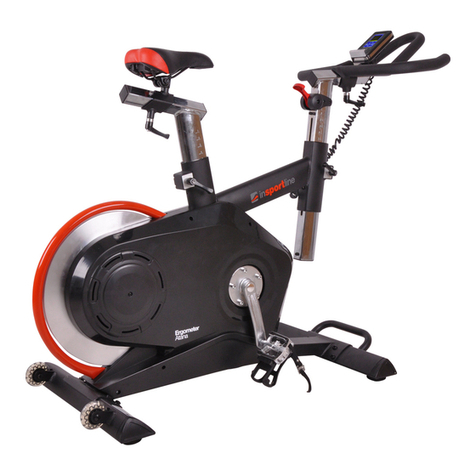
Insportline
Insportline IN 8727 Atana user manual
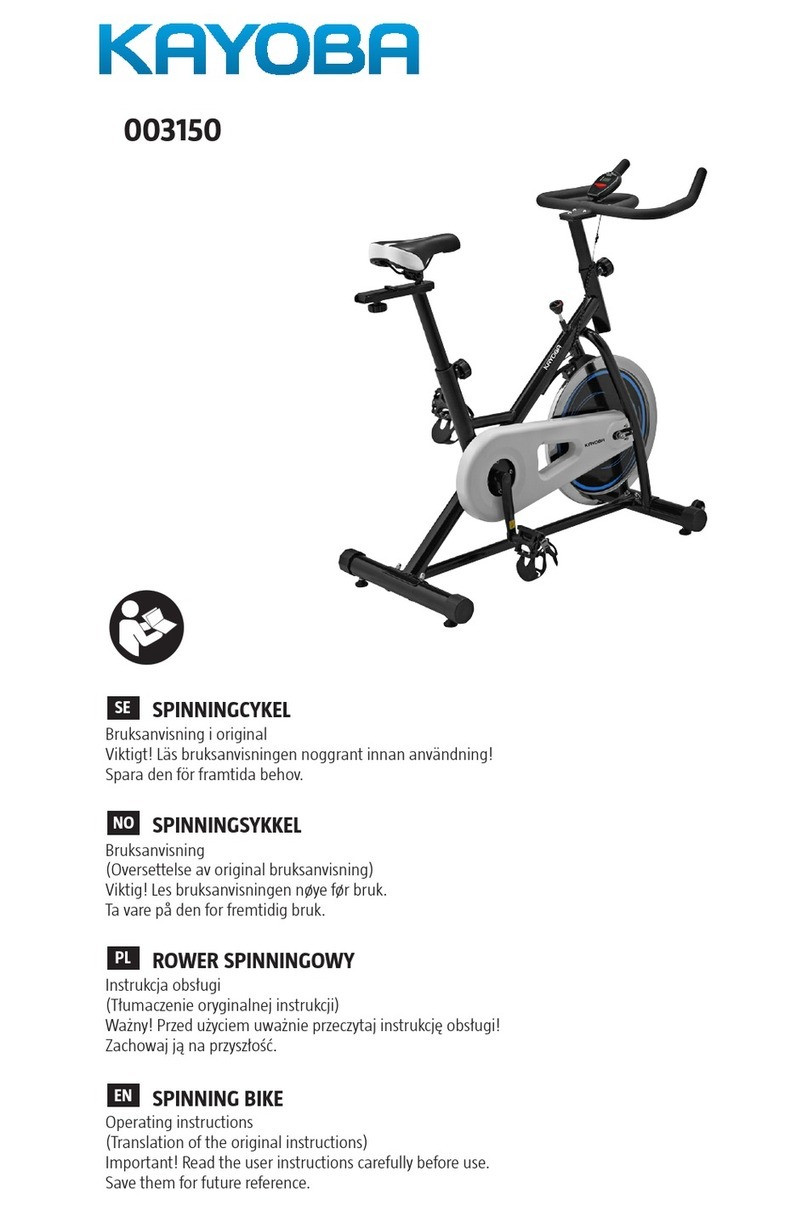
Kayoba
Kayoba 003150 operating instructions
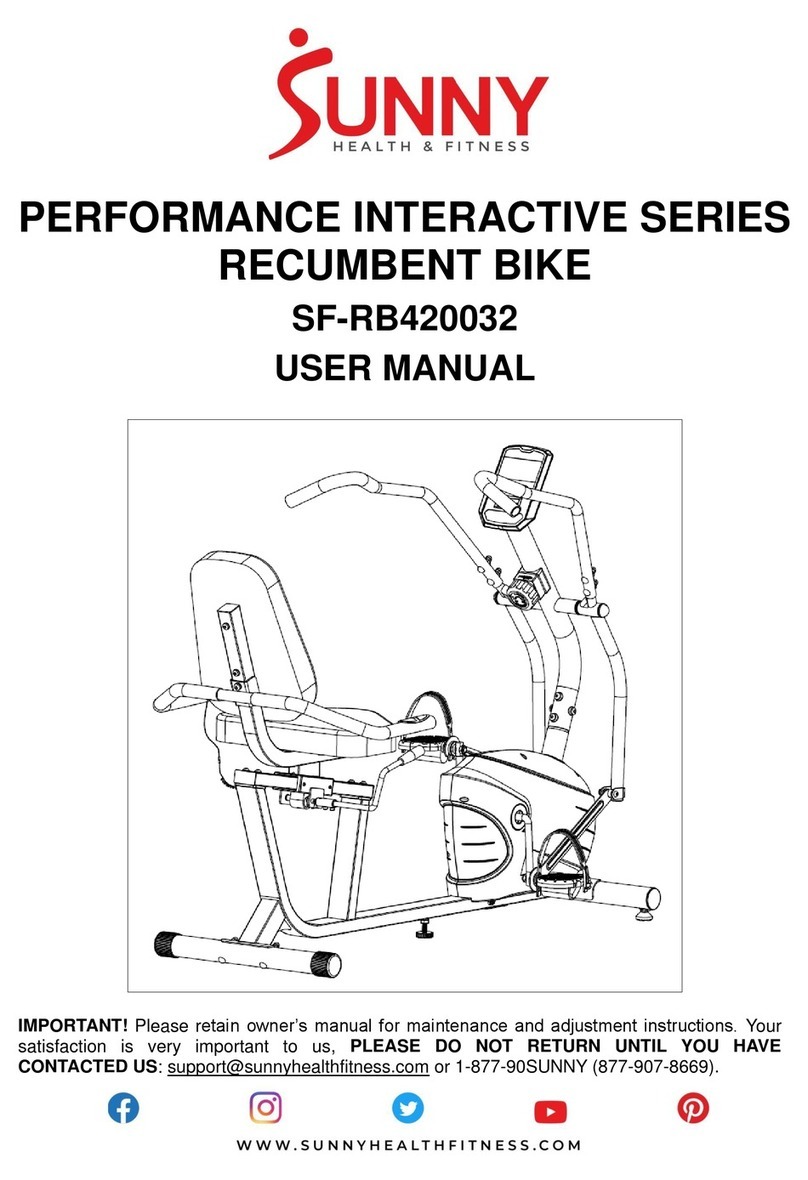
Sunny Health & Fitness
Sunny Health & Fitness PERFORMANCE INTERACTIVE Series user manual

Yeti Cycles
Yeti Cycles 2011 DJ owner's manual
ICON Health & Fitness
ICON Health & Fitness PRO-FORM Le Tour de France CSC user manual

